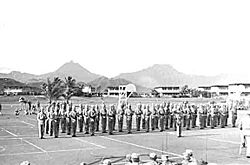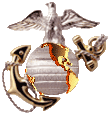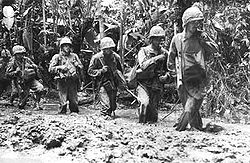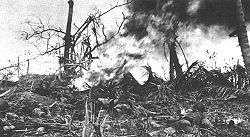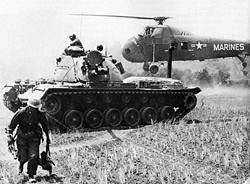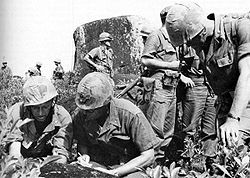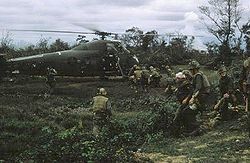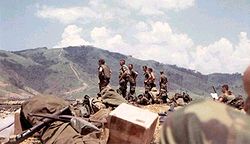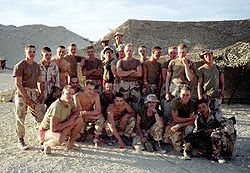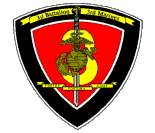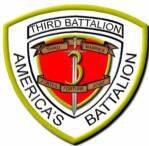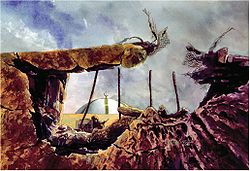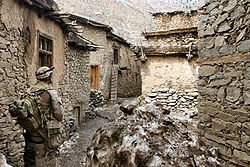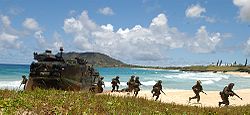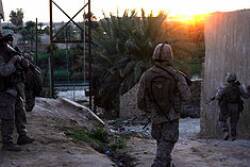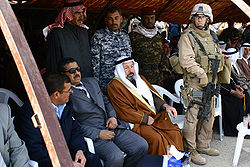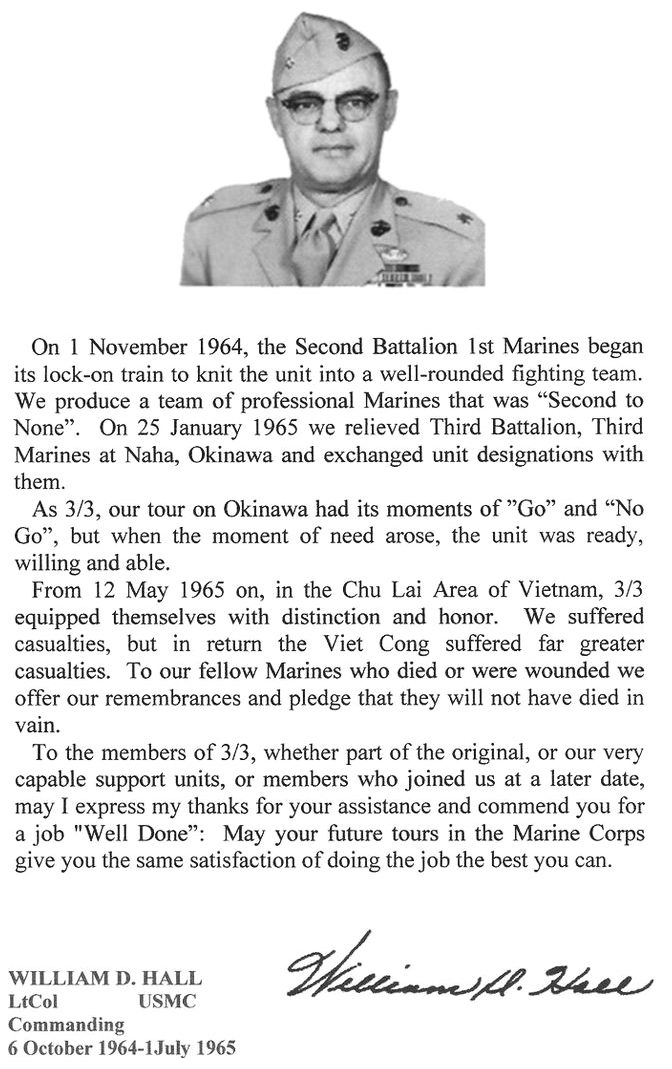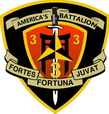
Organization
Like many infantry battalions in the Marine Corps, 3rd Battalion 3rd Marines consists of five companies: three (or four) rifle companies, a Headquarters and Services (H&S) company, and a (or) weapons company. The rifle companies have traditionally been I Co., K Co., L Co., and M Co.] Because the Marine Corps uses the NATO phonetic alphabet, these companies are commonly known as India, Kilo, Lima and Mike. Prior to 1956, under the Joint Army/Navy Phonetic Alphabet, they were known as Item, King, Love, and Mike. The H&S company consists of the battalion staff, and Weapons Company provides fire support coordination, medium mortars, anti-armor weapons, and heavy machine gun support for the rifle companies. [ During peaceful eras the infantry companies were sometimes designated G H I due to reduced forces, and currently have 3 rifle Co's. ]
World War II (1942–1945)
Formation and Deployment (1942–1943)
3rd Battalion 3rd Marines was activated on June 1, 1942 at New River, North Carolina as the 5th Training Battalion, Division Special Troops, 1st Marine Division, Fleet Marine Force. On June 16, they were redesignated as the 3rd Battalion, 3rd Marines, Fleet Marine Force. In August to September 1942, 3rd Battalion deployed with the rest of the 3rd Marine Regiment to Tutuila, American Samoa and was reassigned to the 2nd Marine Brigade. In 1943, they were reassigned to the Fleet Marine Force. In May 1943, they redeployed to Auckland, New Zealand and in June, were reassigned to the 3rd Marine Division. From July to August 1943, they redeployed to Guadalcanal to begin training in preparation for the invasion of Bougainville in November.
Bougainville (1943)
Marines from the 3rd Regiment on Bougainville.
There are no identifiable pictures of 3rd Battalion
during this campaign.
Bougainville campaign
On November 1, 1943, the 3rd Battalion landed at Cape Torokina with the rest of 3rd Marines, just east of the Koromokina River. While resistance was extremely light, the rough surf and dense jungle (which in many places extended all the way to the water) resulted in numerous landing craft being lost or damaged beyond repair. For the next two weeks, the battalion helped construct a series of trails that linked the beachhead with the advancing units, and made supply much easier. On November 16 the battalion reached the Numa Numa Trail and began probing for Japanese units On November 18 after a sharp firefight near a Japanese roadblock the battalion recovered a Japanese map with valuable intelligence on enemy defenses. From November 19-21 the battalion continued probing for the enemy, now identified as the Japanese 23rd Infantry Regiment, and engaging in sporadic firefights. In the lead-up to the Battle of Piva Forks, 3rd Battalion was able to seize critical high terrain that would give the Marines the advantage in the upcoming fight. The actual battle, from November 22–26, saw some of the most vicious close combat experienced in the Pacific War as of that date. 3rd Battalion additionally suffered many casualties from unusually accurate Japanese mortar and artillery fire. Two days later, after 27 days of contiuous action, 3rd Battalion was moved to a relatively quiet sector on the 3rd Division's flank where it remained for the remainder of the operation. In December, the 3rd Marine Division was relieved by the Army's Americal Division and 3rd Battalion left Bougainville for Guadalcanal on Christmas Day, 1943 with the rest of the division. They left behind 36 of their comrades, including Corporal John Logan Jr. and Captain Robert Turnbull (Lima Company), who were both awarded Navy Crosses during the Battle of Piva Forks. 165 other Marines from 3rd Battalion became casualties during the campaign. After Bougainville, 3rd Battalion conducted numerous training exercises on Guadalcanal from January to May 1944 in preparation for the invasion of Kavieng in April (which was cancelled) and the Marianas in June. While 3rd Marines was designated as the floating reserve for the initial invasion of Saipan, they were ultimately not landed and returned to Eniwetok for a three week stay prior to the invasion of Guam. During the interlude, the Marines of 3rd Battalion were primarily confined to their transport ship, the USS Warren.
Guam (1944)
3rd Battalion Marines engaging Japanese
positions on Guam with a flamethrower.
Battle of Guam (1944)
On July 21, 1944, around 0830, 3rd Battalion hit the beaches on the extreme left of the entire 3rd Marine Division. Their mission was to take Chonito Cliff and Adelup Point, which marked the left flank of the division. Supported by half-tracks and armor from the 3rd Tank Battalion, 3rd Battalion fought a bloody, three-hour battle up the side of Chonito Cliff and became the only unit in 3rd Marines to accomplish its objectives by the end of W-Day. During the first night, a mortarman with Kilo Company, Private First Class Luther Skaggs, Jr., was critically wounded in the leg by a Japanese grenade. After applying a tourniquet, Skaggs continued to fight for another eight hours before moving unassisted to the rear where most of his leg was amputated. For this he became the first Marine from 3rd Battalion to be awarded the Medal of Honor. Two other Marines from
3rd Battalion, including battalion commander Lieutenant Colonel Ralph Houser, were awarded the Navy Cross that day.
After securing Adelup Point, 3rd Battalion provided flank security for the rest of the 3rd Marines during the Battle for Bundschu Ridge, the counterattack on the 25th which broke the back of Japanese resistance, and the assault on Fonte Plateau. During these actions, Lieutenant Colonel Houser was seriously wounded and the Executive Officer, Major Royal R. Bastian, Jr., took command. On July 31, 3rd Battalion proceeded east on the Mt. Tenjo road towards the island capital of Agana, which it liberated the same day after token resistance. For the remaining ten days of the campaign, the battalion marched northeast up the coast, encountering occasional enemy resistance, until the island was declared secure on August 10th. Casualties for the 3rd Battalion were twice that of Bougainville, with 300 wounded and 97 killed.
Iwo Jima and Japan (1945)
Following the invasion of Guam, 3rd Battalion spent two months conducting mopping up operations on the island until November, when it received orders to prepare for operations against Iwo Jima. From November until February 1945, they took part in a training regimen so serious that a fellow battalion later reported at least 20% of its members were incapacitated due to foot and heat injuries. During the Battle of Iwo Jima, 3rd Battalion, as part of 3rd Marines, was kept offshore as the Expeditionary Troops reserve. However, despite numerous requests from other Marine officers, the 3rd Marines spent its time at Iwo Jima sitting in its transport ships. On March 5, 1945, the 3rd Marines were ordered to return to Guam.
Back on Guam, 3rd Battalion began training for a landing on Miyako Jima, an island just south of Okinawa. Those orders were eventually cancelled, but the battalion still saw minor combat in 1945, participating in two operations on Guam designed to capture Japanese soldiers still holding out in the hills. These sweeps took place in April and December 1945. 3rd Battalion also began preparing for Operation Olympic, where as part of V Amphibious Corps, it would have landed at Kushikino, Kagoshima on Kyūshū. After the dropping of the atomic bombs in August 1945, and Japan's surrender, 3rd Battalion was detached from the 3rd Marine Division in November 1945 and deactivated the following month on December 12, 1945. Shortly before it was deactivated the Battalion suffered the dubious honor of having the last American killed in World War II, when PFC W.C. Patrick Bates of Company K was shot by a Japanese sniper on December 14 during a mopping up operation on Guam (three months after the formal end of hostilities).
Early Cold War (1951–1965)
3rd Battalion, 3rd Marines arriving in Hawaii, 1953
3rd Battalion 3rd Marines was reactivated at Marine Corps Base Camp Pendleton in August 1951 as part of the 3rd Marine Brigade. In February 1952, it took part in Lex-Baker-1, which was the first full-scale Marine-Navy exercise held on the West Coast since 1949. In May, India Company participated in the ground portion of the Operation Buster-Jangle atomic bomb tests in Nevada. In August, part of the battalion took part in an amphibious landing on Lake Washington as part of Seattle's "Seafair." Then in December, 3rd Battalion took part in one of the first exercises at Twentynine Palms, California. The entire 3rd Marine Division, including 3rd Battalion 3rd Marines, was transported more than 280 miles (451 km) by truck between MCB Camp Pendleton and Twenty-nine Palms. During the exercise, Third Battalion made a night airlift using over 60 helicopters.
In January 1953, the unit deployed to the Marine Corps Air Station Kaneohe Bay on Oahu for six months of training, after which 3rd Battalion 3rd Marines returned to Pendleton. In August 1953, 3rd Battalion deployed to Japan for training operations at Kin Beach, Okinawa and Iwo Jima. In 1956, 3rd Battalion was afloat in the Indian Ocean when the Suez War broke out. Though alerted for possible action in Egypt and the surrounding region, the crisis was ultimately resolved. During this cruise, 3rd Battalion visited Brunei Bay, Bombay, Karachi, and Singapore, before returning to Japan. In December 1956, the entire 3rd Marine Regiment was deployed off of Indonesia because of civil strife in that country. In 1958, 3rd Battalion was alerted for possible deployment to Lebanon, but its transports were turned back in the Indian Ocean to Okinawa. Four years later, in 1962, the battalion deployed on the USS Bayfield to the Chinese coast to guard the Taiwanese islands of Quemoy Matsu.
Vietnam War (1965–1969)
Deployment and Operation Starlite (1965)
Tank A-32 (attached to 3rd Battalion) during Operation Starlite.
Operation Starlite
In January 1965, the 2nd Battalion, 1st Marines at Marine Corps Base Camp Pendleton, California deployed for a tour on Okinawa, Japan where they were redesignated the 3rd Battalion, 3rd Marines. At the time the Marines of 3rd Battalion expected a typical 13-month deployment followed by a quick return to the States. However the battalion found itself caught up in the initial deployment of Marine units to Vietnam, and landed on May 12 along the coast south of Danang at an airfield called Chu Lai. The battalion's first major operation in the Vietnam War was Operation Starlite where they teamed up with units of the 7th Marines. Operation Starlite was aimed at destroying the 1st Viet Cong (VC) Regiment, which was preparing to attack Chu Lai from the Van Tuong peninsula. The fighting began on August 18 when the battalion conducted an amphibious landing just east of the VC positions. At first the attack was slowed by effective VC delaying tactics. However, 3rd Battalion eventually advanced to the outskirts of the village of An Cuong 2. While attempting to clear the village, India Company came under intense fire from VC defending the village. When one squad under Corporal Robert E. O'Malley was ambushed, O'Malley jumped into a VC trench and personally killed eight Viet Cong. Wounded three times, O'Malley refused to be evacuated until all his men were safe and was later awarded the Medal of Honor. India Company then had to fight its way back to the rest of the battalion through other Viet Cong units still operating in the area. Around 1200, an H&S Company supply convoy bound for India Company was ambushed and a force sent to relieve them was also pinned down. The ordeal was covered by Peter Arnett in his article "The Death of Supply Column 21". During the afternoon the situation was stabilized and the Viet Cong retreated that night, resulting in a tactical American victory. The United States had 52 Marines killed in Starlite. India Company lost 14 dead, including the company commander, and 53 wounded out of a force of 177 Marines. Three Navy Crosses were awarded to Marines from the battalion for actions during Starlite, including the battalion commander Lieutenant Colonel Joseph Muir.
Search and Destroy Near Da Nang (1965–1966)
Battalion Commander LtCol Joshua Dorsey III (left)
during Operation Harvest Moon.
Following Starlite the battalion continued to conduct regular sweeps and low-level (i.e. small unit) combat operations against the Viet Cong (usually the 1st VC Regiment) in the greater Da Nang area. In November they participated in an amphbious operation similar to Starlite called Blue Marlin (II), which was carried out near Hoi An. Contact was irregular as the VC attempted to avoid a drawn-out engagement and the battalion only had three Marines wounded. Then in December the battalion moved northwest of Chu Lai to help conduct Operation Harvest Moon. Among the casualties suffered during this period was Lieutenant Colonel Muir, who was killed when he stepped on an IED. In March 1966, 3rd Battalion participated in Operation Kings, officially a search and destroy mission in the An Hoa region, but really an attempt to create a long-term occupation in a historical Viet Cong stronghold. However, any progress gained in Kings was immediately negated by the Buddhist Uprising just one week later in Da Nang. In July, the battalion acted as a blocking force during Operation Macon but did not see significant action.
In August, 3rd Battalion was relieved and left Vietnam for Okinawa. The battalion would not be gone long though, and in early October was stationed offshore as BLT 3/3 near the northern portion of I Corps to combat a possible North Vietnamese invasion. The threat never materialized and BLT 3/3 returned to Vietnam later that month.
Fighting Near the DMZ (1966–1968)
3rd Battalion conducts a Medevac while
operating along the DMZ, 1968.
In October 1966, 3rd Battalion was deployed to combat the threat from the North Vietnamese Army in Quang Tri province. This would be a largely conventional fight that would continue into 1967. In December, the battalion suffered a tragic case of friendly fire when a pair of F-4 Phantoms dropped several bombs in the middle of Mike Company, killing seventeen Marines and wounding a dozen others. Corpsman Donald Rion was awarded a posthumous Silver Star for his efforts to treat the wounded, despite suffering a mortal wound himself. In the spring of 1967, 3rd Battalion participated in a series of bloody engagements near Khe Sanh known as the Hill fights, culminating in the Battle of Hill 881, where 46 Marines from the battalion were killed. The violence in the area continued to increase throughout 1967, culminating in 1968's Tet Offensive. While deployed in Quang Tri, 3rd Battalion fought in such places as the Rockpile, Cam Lo, A-3, Gio Linh, Khe Sanh, and Con Thien.
Taylor Common and Redeployment (1969)
3rd Battalion 3rd Marines's command group
at Vandegrift Combat Base, 1969.
Operation Taylor Common
In early 1969, 3rd Battalion 3rd Marines was sent south for several months to join Task Force Yankee in Operation Taylor Common near An Hoa. This three-month operation focused on destroying the primary base for North Vietnamese Army forces operating across several provinces and 3rd Battalion was awarded a Navy Unit Commendation for its actions during the operation. Ten Marines from 3rd Battalion were killed during the operation (out of 183 total US fatalities), and American forces captured numerous quantities of North Vietnamese armies and supplies. One Marine, Lance Corporal William R. Prom, was posthumously awarded the Medal of Honor for gallantry during Taylor Common.
In March, 1969, while M/3/3 was opcon to 1/4 at LZ Alpine, PFC Ronald L. Coker was posthumously awarded the Medal of Honor for gallantry in action. In July 1969, the battalion took part in Operations Virginia Ridge and Idaho Canyon, attempting to stop North Vietnamese infiltrators coming through the DMZ. The operation continued until September, when the 3rd Marine Regiment was ordered to stop operations in preparation for its redeployment back to the United States. The battalion began to depart on October 7 and had fully arrived at MCB Camp Pendleton by the end of 1969. 3rd Battalion spent over 1,600 days in Vietnam and conducted 48 combat operations, the most of any Marine battalion in the conflict. 653 Marines who served in 3rd Battalion 3rd Marines lost their lives during the Vietnam War or were killed while operating with other units. Nearly 2,800 others were wounded.
Late Cold War (1969–1974, 1975–1990)
The battalion relocated during October and November 1969 to MCB Camp Pendleton and was reassigned to the 5th Marine Amphibious Brigade. They were again reassigned in April 1971 to the 1st Marine Division. The battalion was deactivated June 1, 1974. 3rd Battalion 3rd Marines was reactivated on October 1, 1975 at MCB Kaneohe Bay, Hawaii, and assigned to the 3rd Marine Division. Elements of the battalion deployed to the Western Pacific at various times during the 1970s and 1980s. Robert K Leonard proudly served as the Platoon Commander of 2nd Platoon, India Company, 3/3, First Marine Brigade, FMF in the late 1970s. He presents some of the 3/3 history from the mid 70's: The 3rd Marine Regiment based at MCAS Kaneohe Bay, Hawaii with the 1st Marine Brigade received orders in 1977 to begin training a modern-day Raider Company within each of its infantry Battalions. Earlier that same year, the 3rd Marines had been the first FMF Regiment to be issued the new jungle camouflaged utility uniform. The fierce look of this new uniform helped foster an enhanced level of the warrior ethos throughout the Regiment creating the ideal cultural setting for the new Raider Companies. Under the leadership of Captain Robert S. Cohen, India Company, 3rd Battalion, 3rd Marines was the first to undergo a transformation from a traditional FMF rifle Company into highly specialized Raider Teams capable of executing this new counter-terrorism mission. Affectionately called “Mighty India, Raider Company” by its officers and men, India 3/3 began the intense training required to master many of the tactics used by the Israeli “Sayeret Matkal” and other Special Forces from around the globe. The Company even adapted an unofficial unit insignia inspired by the famous skull patch used by World War II Raider Battalions. The insignia used by India Company featured a scarlet and gold painted double winged human skull in front of a vertical commando's Stiletto Knife. The insignia contained the words "Mighty India, Raider Company" and "Death from Above." It was painted on a sign and proudly displayed outside India 3/3 Company Headquarters located at MCAS Kaneohe Bay during this time period. Several Marines even had the insignia tattooed on their arms. The intense level of training and tactical proficiency achieved by “Mighty India, Raider Company” was perhaps best exemplified when Marines from the Company won the annual “Top Squad in the Corps” competition at Marine Corps Base Quantico, Virginia soon after it’s transformation into a Raider Company. This honor went to the best 13- man Squad within the entire Marine Corps. The winning Squad was lead by a 21 year old Sergeant named R. L. Mims who was meritoriously promoted to Staff Sergeant for his outstanding leadership skills making him the youngest Staff NCO in the Marine Corps at the time. Other high profile Marines who served with India 3/3 during this time period included a Platoon Commander named First Lieutenant Thomas X. Hammes who later became a well-known “Marine Corps Gazette” distinguished author. Before his retirement at the rank of Colonel he also authored the book “The Sling and the Stone: On War in the 21st Century” making him one of the first military thought-leaders to define fourth generation warfare. He later authored the book: "Forgotten Warriors: The 1st Provisional Marine Brigade, The Corps' Ethos, and the Korean War." Although the new Marine Raider concept during the late 1970s was low profiled, short-lived and never fully actualized by other infantry Battalions within the FMF, the special training and innovative tactics developed and used by India 3/3 during this time period were eventually passed up the chain of command for the future adaptation and usage by other “Special Operations Capable” trained U.S. Marine units. Although this brief part of its proud history is not widely known by others, India 3/3 played a small but significant role in the development and training of counter-terrorism tactics used by the U.S. Marine Corps today. In February 1980, following the Soviet invasion of Afghanistan, the battalion was deployed to the Persian Gulf onboard the USS Okinawa and was also the back-up force during Operation Eagle Claw. This deployment made 3rd Battalion the first American ground unit to enter the region since World War II.
In the summer of 1983, the battalion was in Mombassa, Kenya as part of the 31st MAU when the Joint Chiefs of Staff ordered it to the Mediterranean in support of the Multinational Force in Lebanon during the Lebanese Civil War. It arrived on September 12 and spent three weeks off the coast as a reserve force for the 24th MAU on the USS Tarawa, before departing on October 9 for the Indian Ocean because of a crisis near the Strait of Hormuz.
Gulf War (1990–1991)
Members of India Company during the
Desert Shield/Desert Storm deployment
Defending Saudi Arabia (1990) Operation Desert Shield
In 1990, 3rd Battalion was finishing up a deployment at Camp Hansen on Okinawa when on August 2 at 0200 the commanding officer of the 9th Marine Regiment notified the battalion to be prepared to immediately redeploy to Saudi Arabia as a response to the Iraqi invasion of Kuwait. No sooner had the battalion returned to Hawaii, then it was shipped out again to Saudi Arabia as part of the 1st Marine Expeditionary Brigade. As one of the first Marine units in country, 3rd Battalion found itself defending a key position at Cement Ridge, about 90 kilometers away from the Kuwaiti border. With orders to hold against any Iraqi attack, 3rd battalion spent most of the months of August and September digging defensive positions. In October, 3rd Battalion and 2nd Battalion 3rd Marines (2/3) were designated "Task Force Taro" and moved to the extreme right flank of the Marine sector, bordering the Saudi Arabian King Abdul Aziz Brigade. Because of their close proximity, Taro was ordered to begin cross-training with the Saudi forces. This cross-training continued through January, when 3rd Battalion was moved forward to defend Al Mish'ab along the Saudi coast and became the northernmost Marine combat force in Saudi Arabia.
Desert Storm, Khafji, and Kuwait (1991)
Marines of 3rd Battalion, 3rd Marines searching
Khafji for Iraqi stragglers following the battle in
the painting “Cleaning up Khafji”.
Battle of Khafji and Liberation of Kuwait campaign
Operation Desert Storm began on January 17, 1991, but for the first two weeks 3rd Battalion only conducted sporadic engagements with its Iraqi counterparts across the border. That all changed on January 29, when several Iraqi divisions unexpectedly crossed the border and seized the Saudi town of Khafji, less than 15 kilometers north of 3rd Battalion's position. During the attack the Executive Officer along with the Battalion Sergeant Major drove into the town on a rescue mission looking for two Army soldiers who had been captured. Although they were unable to find them, the Marines from 3rd Battalion did blunder into an Iraqi patrol and exchanged rounds with them before making their own escape. While Saudi and Qatari units ultimately retook the town, 3rd Battalion played a vital role in both coordinating the attack and blocking further Iraqi advances southward. In addition, several heavy machine guns and forward air controllers from the battalion were shifted over to the Saudis and took place in the assault. From February 19–21, 3rd Battalion moved from Al Mish'ab to the forward assembly areas that it would be using to launch its attack into Kuwait. It was also during this period that 3rd Battalion was given its assignment for the ground offensive. Lacking heavy armor or motorized transport, the battalion (along with 2/3) would infiltrate Iraqi positions along the Saudi border and provide flank security for the rest of the 1st Marine Division to make its assault into Kuwait. On the night of February 22, 3rd Battalion crossed the border into Kuwait, infiltrating past Iraqi minefields, tank traps, and other obstacles. Like many American units, 3rd Battalion encountered no Iraqi resistance and the biggest threat to the Marines came from friendly fire. Throughout the ground war, the battalion advanced steadily northwards, encountering no resistance but taking plenty of prisoners, and arrived outside the Kuwait International Airport around February 27 where a SCUD missile landed near the battalion's command post. Several months later, 3rd Battalion returned to Hawaii, having suffered no combat casualties.
Post Cold-War (1991–2004)
3rd Battalion Marines disembark AAVs on Marine
Corps Base Hawaii during RIMPAC 2004.
Between its participation in Desert Storm and the Afghan War, 3rd Battalion conducted multiple deployments around the Pacific Rim. In August 1991 the battalion participated in Operation Tafakula in Tonga, an international exercise involving elements of the French military and the Tongan Defence Services. On June 8, 1994 India Company participated in the 50th Anniversary of the Invasion of Saipan. In October 1994 3/3 was reassigned to the 3rd Marine Division In 2002 the battalion participated in Operation Millenium Edge on Tinian and Guam, then Balikatan 02-2 in the Philippines, Borneo, Brunei, Korea, Australia, and Japan. In 2003 3rd Battalion became Battalion Landing Team (BLT) 3/3 on the 31st Marine Expeditionary Unit for the second half of the year. Based on the USS Essex, USS Fort McHenry, and USS Harpers Ferry, BLT 3/3 participated in the Amphibious Readiness Group Exercise 03 (ARGEX-03) in the Philippines, provided security for President George W. Bush on Bali, Indonesia, and also visited Japan, Australia, East Timor, and Hong Kong.
Global War on Terror (2004–2010)
War in Afghanistan (2004–2005, 2010)
A Corpsman with Kilo Company in Afghanistan, 2005.
War in Afghanistan (2001–present)
In late 2004, 3rd Battalion was notified it would be participating in Operation Enduring Freedom. On October 31, the first Marines left Kaneohe Bay, Hawaii for an eight month deployment to eastern Afghanistan. While serving in Afghanistan, 3rd Battalion conducted Operation Spurs in February 2005, where they were inserted into the Korangal valley and conducted both counterinsurgency and humanitarian operations. In March 3rd Battalion launched a similar sweep called Operation Mavericks. During their time in Afghanistan, the Marines from 3rd Battalion engaged the Taliban in 22 firefights. In one of them the battalion suffered its only fatalities for the deployment when Lance Corporal Nicholas Kirven and Corporal Richard Schoener were killed during a three-hour firefight in Alishang which also resulted in twenty-three Taliban killed. During the fighting, Lieutenant Stephen Boada was awarded the Silver Star for calmly directing bombing runs on Taliban positions, despite having been wounded several times. In May the battalion launched one final operation, Operation Celtics, in the Tora Bora region. The operation was for the most part uneventful, although NBC news journalist Ron Allen was almost killed while traveling with Kilo Company when his Humvee ran over an IED. In December 2009 the I Marine Expeditionary Force announced in a press release that 3rd Battalion would be deploying to Afghanistan sometime in 2010.
The Iraq War (2006–2009)
Al Anbar campaign
Kilo Company Marines patrolling
the Haditha Triad in Iraq, 2006.
In March 2006, 3rd Battalion 3rd Marines deployed to western Iraq in support of Operation Iraqi Freedom. They relieved in place the 3rd Battalion 1st Marines in the Haditha area and were based out of the Haditha Dam. This deployment was particularly sensitive, coming around the same time that news of the Haditha killings broke in the United States. Once it arrived in Iraq, 3rd Battalion was given the mission of "fighting insurgents, working with locals to improve local economy and quality of life, and training Iraqi soldiers." The Battalion was also partnered up with the 2nd Battalion, 2nd Brigade of the 7th Iraqi Army Division. 3rd Battalion attempted to secure Haditha by using an approach of "constant presence". The battalion operated from a series of forward operating bases in the local cities of Haditha, Barwanah, Haqlaniyah, and Baghdadi from which the rifle and weapons companies sent out constant patrols to keep the insurgent groups off balance. However, the battalion was unable to create a working local police force, due to the overwhelming intimidation by insurgent groups. By June, attacks against Marines in Haqlaniyah had become common, with their base getting mortared about twice a week and some insurgents getting close enough to throw grenades over the wall into the base. During their time in Haditha the Marines from 3rd Battalion 3rd Marines conducted more than 8,000 patrols, located 54 weapons caches and detained more than 800 suspected insurgents. The battalion had eleven Marines killed and eighty-five wounded. On October 6, 3rd Battalion 3rd Marines returned to Kaneohe Bay.
Battalion Commander LtCol Nathan Nastase
with members of the Karmah
City council in Iraq, 2007. Many of these individuals would be killed in June 2008 when a suicide bomber attacked the council.The following year in August the battalion made its second Iraq deployment, this time to the Fallujah area in eastern Anbar province where they served under the Regimental Combat Team 6 during the closing phases of Operation Alljah. Their mission was to complete the Clear Hold Build operation in the areas of Karmah and Zaidon which 2nd Battalion, 7th Marines had begun two months earlier. By late 2007 the Marines frequently found themselves mediating between sheiks, assisting locals with reconstruction projects, and mentoring the Iraqi police units in the area. The battalion spent more than one million dollars on Karmah, including a city council and a medical clinic. On December 1, the battalion staged an elaborate reopening of "Victory Circle", or "The Lollipop", the marketplace in the center of Karmah which had earlier been the scene of fierce fighting between Marines and insurgents. In February 2008 the battalion was once again relieved by 2nd Battalion, 3rd Marines and rotated back to the United States without suffering a single casualty.
In April 2009 3rd Battalion deployed for a third time to Iraq, this time to Al Asad in Anbar Province. On that deployment, they made up "Task Force Military Police" in MNF-W. Task Force Military Police (TFMP) was a support unit fulfilling security responsibilities through Anbar Province, including conducting convoy security missions (sometimes military, sometimes contractor) and detainee releases, running regional detention facilities, and also managing the military working dogs in MNF-W. In addition, since November 2008 it had been tasked with securing Combat Outpost Heider in Rabiah in support of Operation Defeat Al Qaeda in the North. In late July Marines from the battalion operating as Task Force Personnel Recovery participated in the search and eventual recovery of Navy Captain Scott Speicher.
3rd Battalion 3rd Marines deactivated and retired their Colors on January 13, 2023.
Unit awards
Since the beginning of World War II, the United States military has honored various units for extraordinary heroism or outstanding non-combat service. This information is compiled by the United States Marine Corps History Division and is certified by the Commandant of the Marine Corps.
America's Battalion
According to research by the Marine Corps' History and Museum Division, the name "America's Battalion" originated in the mid-1980s when Lieutenant Colonel Charles Krulak was the battalion's commanding officer. It comes from the nickname "America's Team", which was used by the Dallas Cowboys. Krulak, who was a big Cowboys fan, modified the nickname to apply to 3rd Battalion. According to Krulak, at one point a friend of his sent him a letter addressed to the "Commanding Officer, America's Battalion". With nothing else on the envelope, the United States Postal Service still managed to deliver the letter properly. Krulak commented that "if the U.S. Postal Service recognized 3rd Battalion 3rd Marines as 'America's Battalion,' then they certainly must be. So from then on he considered it 'official'." 3rd Battalion is one of two battalions to have the nickname "America's Battalion", the other being 2nd Battalion 8th Marines based out of Marine Corps Base Camp Lejeune.
Notable 3rd Battalion Marines
Among the many decorations for valor and bravery awarded to Marines from 3rd Battalion, four Medals of Honor and over twenty Navy Crosses have been awarded for service while with 3/3. Cpl Luther Skaggs, Jr. was awared the Medal Of Honor in 1944. 3/3 alumnus HM3 Robert C. Benfold received the Medal of Honor posthumously in 1952. In 1965, Corporal Robert O'Malley from India Company became the first Marine in the Vietnam War to be awarded the Medal of Honor. In early 1969 LCpl William R. Prom of India 3/3 and PFC Ronald L. Coker of Mike Company were posthumously awarded the Medal Of Honor. Two other Marines from 3rd Battalion 3rd Marines, Major Robert J. Modrzejewski (1958–1959) and Lt Col. Howard V. Lee (1959–1960), would later be awarded the Medal of Honor in Vietnam while serving with other units. Colonel John Ripley (hero of the bridge at Dong Ha) was in command of Lima Company in 1967, and the company was frequently referred to as "Ripley's Raiders". Lt Col. Oliver North served as a platoon commander in Kilo Company from 1968–1969 and Frank Tejeda, a Congressman from Texas, was a Kilo NCO in 1969. In the early 1950's Major General Sidney Sanders McMath was elected the 34th governor of Arkansas. In more recent years, General Charles Krulak, the 31st Commandant of the Marine Corps served as Battalion Commander from 1983–1985 and is credited with giving 3rd Battalion 3rd Marines the nickname "America's Battalion". Sgt Dakota L. Meyers was awarded the Medal Of Honor in 2009.
sources:
Wikipedia,
Cpl Justin Palmer K/3/3,
USMC archives

More 3/3 history pages are included on the links below, and the Co. sites included in our Links Pages
It is our hope that these efforts will be informative, and an educational journey into our past.
| Streamer | Award | Year(s) | Additional Info |
| Presidential Unit Citation Streamer with one Bronze Star | 1944, 1965–1967 | Battle of Guam (Citation), Vietnam War (Citation) | |
| Navy Unit Commendation Streamer with four Bronze Stars | 1943, 1965, 1968–1969, 1990–1991, 2006 | Battle of Bougainville (Citation), Operation Starlite (Citation), Operation Taylor Common (Citation), Desert Storm (Citation), Iraq War (Citation) | |
| Meritorious Unit Commendation Streamer with three Bronze Stars | 1967–1968, 1968, 1983, 2004–2005 | Cam Lộ District (Citation), Quảng Trị Province (Citation), Lebanon, Afghan War (Citation) | |
| Marine Corps Expeditionary Streamer | 1983 | Lebanon | |
| Asiatic-Pacific Campaign Streamer with four Bronze Stars | 1943–1945 | Treasury-Bougainville Operation, Consolidation of Solomon Islands, Marianas Operation, Iwo Jima Operation | |
| World War II Victory Streamer | 1942–1945 | Pacific War | |
| National Defense Service Streamer with three Bronze Stars | 1951–1954, 1961–1974, 1990–1995, 2001–present | Korean War, Vietnam War, Gulf War, War on Terrorism | |
| Korean Service Streamer | 1953–1954 | 3rd Battalion 3rd Marines never actually fought in Korea, but was stationed in Japan through most of the Korean War as a reserve force. | |
| Armed Forces Expeditionary Streamer | 1962 | Quemoy and Matsu Islands | |
| Vietnam Service Streamer with two Silver Stars | 1965–1969 | Vietnam Defense Campaign, Vietnam Counteroffensive, Vietnam Counteroffensive Phase II, Vietnam Counteroffensive Phase III, Tet Counteroffensive, Vietnam Counteroffensive Phase IV, Vietnam Counteroffensive Phase V, Vietnam Counteroffensive Phase VI, Tet 69/Counteroffensive, Vietnam Summer-Fall 1969 | |
| Southwest Asia Service Streamer with two Bronze Stars | 1990–1991 | Defense of Saudi Arabia, Liberation and Defense of Kuwait | |
| Afghanistan Campaign Streamer | 2004–2005 | Consolidation I | |
| Iraq Campaign Streamer | 2006, 2007–2008, 2009 | National Resolution, Iraqi Surge, Iraqi Sovereignty | |
| Global War on Terrorism Service Streamer | 2001–present | ||
| Vietnam Gallantry Cross with Palm Streamer | 1965–1969 |
